Wearable technology for health monitoring allows you to track essential signs like heart rate, sleep, blood pressure, and glucose levels in real time. These devices support remote patient care, early detection of health issues, and personalized insights through AI integration. From fitness trackers to specialized medical patches, wearables are transforming healthcare from reactive to proactive. Keep exploring to discover how these innovations can help you stay healthier and more informed.
Key Takeaways
- Wearable devices enable continuous monitoring of vital signs like heart rate, blood pressure, and glucose levels for proactive health management.
- They facilitate remote patient monitoring, allowing real-time data sharing with healthcare providers outside clinical settings.
- Advanced wearables incorporate biosensors and AI for personalized insights, early detection of health issues, and predictive analytics.
- Specialized wearables track sleep, stress, fertility, pregnancy, and infant health, supporting targeted health interventions.
- Integration with electronic health records and secure data frameworks improves diagnostic accuracy and patient outcomes.
Overview of Wearable Devices in Healthcare
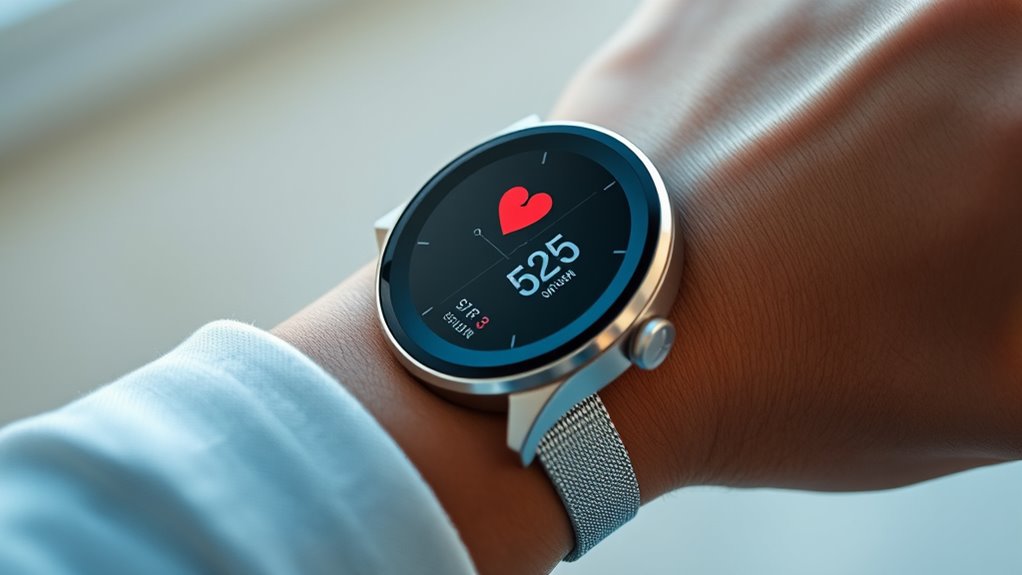
Wearable devices in healthcare have become essential tools for continuous health monitoring. These devices, including smartwatches, fitness trackers, biosensors, ECG monitors, blood pressure cuffs, and glucose meters, collect critical signs and health data around the clock.
They enable remote patient monitoring, allowing you to track your heart rate, blood glucose, and blood pressure outside clinical settings.
Medical-grade wearables, which require FDA approval, are used for managing chronic conditions, while consumer-grade devices focus on general health tracking.
Integration with mobile apps and healthcare systems helps share data, providing real-time insights and personalized health information.
The wearable healthcare market is rapidly expanding, reflecting how these devices are transforming health monitoring from reactive to proactive. Additionally, the incorporation of Natural Language Processing in health monitoring devices enhances user experience by providing personalized insights and recommendations.
Key Features and Capabilities of Health Wearables

The capabilities of health wearables extend beyond simple activity tracking, incorporating advanced sensors and technology that monitor essential signs in real time. You can track crucial signs such as heart rate, blood pressure, glucose levels, and sleep patterns continuously. Many devices feature ECG sensors, allowing you to analyze heart activity remotely and detect irregular rhythms early. These wearables gather extensive health data using various sensors, providing insights into your overall health and safety. Regular maintenance is essential to sustain tuning benefits in health monitoring devices. Advanced models leverage AI and machine learning to process this data, offering personalized health insights and predictive analytics. Additionally, biosensors and epidermal patches deliver non-invasive, continuous biomarker analysis, improving diagnostic accuracy and keeping you engaged in managing your health proactively. Furthermore, recognizing soulmate angel numbers can enhance your awareness of emotional well-being and connections in your life. Engaging with strong communication skills can also help you share your health journey with loved ones, fostering support and understanding. Furthermore, the integration of smart features in wearables enhances user experience by enabling real-time notifications and health monitoring. By staying informed about local resources, users can better utilize their health wearables to connect with healthcare professionals and community support.
Popular Wearable Medical Devices and Their Functions
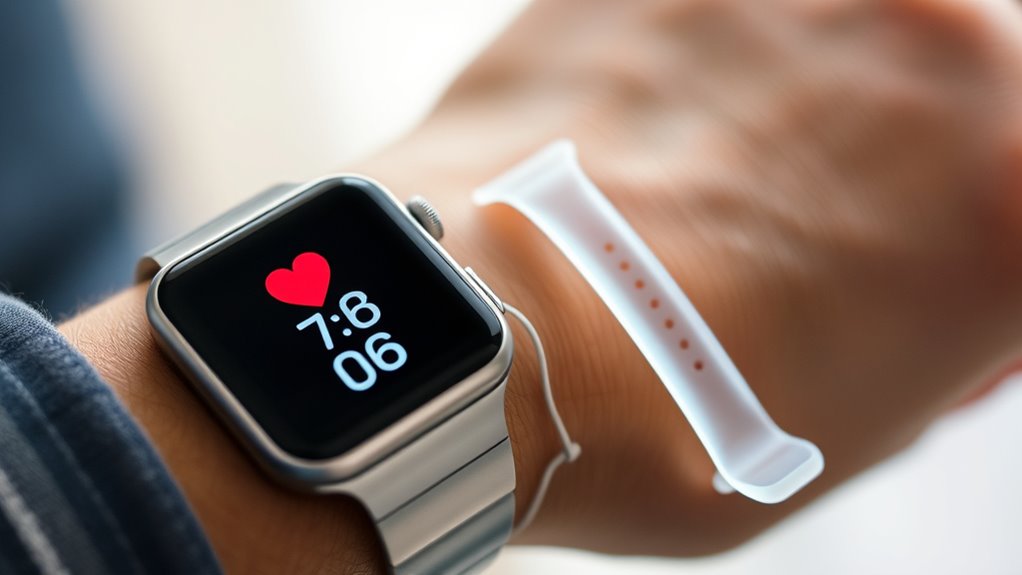
Many wearable devices focus on heart monitoring, helping you track heart rhythms and detect issues early. Expert voice actors are often utilized in ads for these devices, enhancing the credibility of the technology being presented. Sleep and stress trackers provide insights into your daily well-being, so you can manage stress and improve rest. Additionally, regular use of glycolic acid can help improve skin texture and overall appearance, making it a valuable component in personal care routines. For specific needs, fertility and infant monitors offer specialized data to support reproductive health and infant care. Furthermore, many devices utilize high refresh rates to provide real-time feedback for health metrics, enhancing user engagement and accuracy. Additionally, some devices incorporate machine learning algorithms to enhance predictive capabilities in health monitoring. Furthermore, many devices utilize ECU tuning principles to optimize performance and ensure accuracy in health monitoring.
Heart Monitoring Devices
Have you ever wondered how technology can keep an eye on your heart health in real time? Wearable devices like smartwatches and patches offer continuous heart monitoring by tracking your heart rate and recording ECG data. These devices can also support remote work by helping users manage their health from home. Additionally, these wearables promote nutritional information by encouraging users to adopt healthier lifestyles through their health monitoring features. With recent advancements in on-device AI capabilities, these devices are set to enhance user interactions and provide even more insightful health data. Furthermore, many of these devices are designed with sustainability initiatives in mind, aligning with modern health trends.
These devices can detect irregular rhythms and support arrhythmia detection, providing early alerts for conditions like atrial fibrillation. With real-time data, you get instant insights into your heart’s activity, empowering you to take proactive steps.
Devices such as the AliveCor KardiaMobile attach to your smartphone for quick, on-the-go heart rhythm assessments, aiding remote cardiac care. Smartwatches from brands like Apple and Garmin also include ECG features, fall detection, and heart rate notifications, making ongoing heart monitoring accessible and seamless.
These wearables help improve preventive care and support personalized cardiac health management. Additionally, understanding required minimum distributions can provide valuable insights into managing healthcare costs during retirement.
Sleep and Stress Trackers
Building on the continuous health monitoring capabilities of heart devices, wearable sleep and stress trackers expand personalized wellness by providing real-time insights into your sleep patterns and stress levels. These devices use sensors to monitor health data like heart rate variability and skin conductance, giving you detailed information on sleep quality and stress. They can detect early signs of sleep disorders such as sleep apnea and offer personalized tips to improve sleep hygiene, which is crucial for newborn health and development. Moreover, understanding the emotional implications of stress can greatly enhance your overall well-being, as studies indicate that over 40% of marriages in the U.S. end in divorce, often exacerbating stress levels. Additionally, the use of airless paint sprayers in home environments can help maintain a calm and healthy space, reducing stress associated with home improvement tasks. Research shows that proper surface preparation before painting can significantly improve the quality of your finished work, contributing to a less stressful home environment. Stress monitoring features analyze physiological signals to assess your stress levels, helping you manage mental health proactively. Advanced wearables sync with mobile apps, visualizing your data and enabling trend tracking. Additionally, incorporating tools like pimple patches can support targeted treatment of skin issues that may arise due to stress and lack of sleep.
| Sleep & Stress Trackers | Key Functions |
|---|---|
| Sensors for monitoring | Heart rate, skin conductance |
| Data insights | Sleep quality, stress levels |
| Personalized feedback | Sleep improvement, stress management |
Fertility and Infant Monitors
Are wearable devices transforming how you monitor reproductive and infant health? Fertility monitors like Ava Women track essential signs such as sleep, stress, and resting heart rate, providing valuable health data to improve your chances of conception.
Infant wearables, like those from Owlet Baby Care, monitor critical signs including heart rate, oxygen levels, and sleep patterns, offering real-time monitoring for neonatal safety. These devices empower you to detect potential issues early, ensuring timely intervention.
With continuous tracking, you gain insights into your reproductive health and your baby’s well-being, reducing risks and supporting informed decisions. By delivering real-time alerts and weekly updates, these wearable monitors enhance safety and confidence for both parents and women managing fertility or infant care.
Specialized Wearables for Women’s Health and Fertility
Fertility tracking wearables like Ava Women give you precise insights into your cycle, helping you identify your most fertile days. They use advanced sensors to monitor physiological signals, making early ovulation detection possible. As a result, these devices support better family planning and pregnancy monitoring, offering valuable data for you and your healthcare provider. Additionally, understanding your cycle can enhance your overall health and wellness, contributing to grocery savings strategies that may help you manage your family budget more effectively. This knowledge can empower you to make informed decisions about your reproductive health, reinforcing the importance of understanding your cycle. Moreover, incorporating effective wall organization into your living space can create a more serene environment, supporting your overall well-being during this important journey. Engaging with your cycle can also improve your awareness of dream patterns, which may enhance your self-discovery and personal growth.
Fertility Tracking Advances
Have you ever wondered how technology is transforming women’s reproductive health? Fertility tracking devices now offer advanced wearable health solutions that monitor physiological changes, providing personalized insights into your cycle.
These wearables detect subtle shifts in your body’s signals, helping you identify your fertile window with over 90% accuracy. By tracking ovulation, periods, sleep, stress, and resting heart rate, they give you a holistic view of your reproductive health.
The growing popularity of such devices—up by around 25% in recent years—reflects their effectiveness for early detection and health monitoring. These specialized wearables empower you to plan conception more effectively and stay informed about your body’s unique patterns, supporting better overall reproductive health management.
Pregnancy Monitoring Benefits
Specialized wearable devices for women’s health now offer continuous, non-invasive pregnancy monitoring, empowering you to track early signs of conception and pregnancy with ease.
With wearable devices designed for reproductive health, you can monitor fetal health indicators and detect pregnancy signs early through real-time data analysis.
These fertility wearables support precise health tracking, helping you identify fertile windows and ideal conception times.
During pregnancy, they provide valuable insights into hormonal and physiological changes, enabling early detection of potential issues and ensuring better fetal health management.
By integrating these devices into your routine, you gain a proactive approach to pregnancy monitoring, making informed decisions for both your well-being and your baby’s health.
This personalized care enhances outcomes and fosters peace of mind as your pregnancy progresses.
Monitoring Devices for Infants and Newborns

Monitoring devices for infants and newborns have become essential tools for parents and healthcare providers alike. Infant wearables, like Owlet’s devices, track heart rate monitoring, sleep patterns, and oxygen saturation, offering real-time data via mobile apps. These non-invasive devices are designed to be comfortable, encouraging continuous wear without disturbing your baby’s natural behavior. They also support developmental tracking and early health detection, helping identify issues like sleep apnea or oxygen desaturation early on. To highlight the benefits, here’s a comparison:
| Feature | Benefit |
|---|---|
| Heart rate monitoring | Early signs of health concerns |
| Sleep pattern analysis | Better understanding of sleep quality |
| Oxygen saturation | Detects breathing issues quickly |
| Non-invasive design | Ensures comfort and continuous use |
Advances in Biosensor Technology for Continuous Monitoring

Recent advances in biosensor technology make continuous health monitoring more accurate and unobtrusive. Miniaturized, flexible patches and smart fabrics now detect subtle biomarker changes in real-time, enabling proactive care.
When integrated with AI, these devices offer precise insights that support better diagnosis and treatment decisions.
Enhanced Detection Capabilities
Advances in biosensor technology have considerably enhanced the ability to continuously and accurately track essential health biomarkers in real time. You now benefit from highly sensitive biosensors integrated into wearable sensors, enabling continuous detection of biomarkers like cortisol, glucose, and electrolytes.
Microfluidic patches and epidermal sensors analyze bodily fluids instantly, reducing invasive testing and providing seamless health data collection.
Wearable ECG devices, including smartwatches and patches, monitor heart rhythms around the clock, detecting irregularities early. These innovations improve real-time monitoring capabilities, offering more reliable insights into your health status.
Enhanced detection capabilities allow for early intervention and personalized care, empowering you to manage conditions proactively. This progress marks a significant leap forward in wearable health technology, delivering precise, real-time health monitoring.
Miniaturization and Wearability
The miniaturization of biosensors has revolutionized wearable health technology by making devices more comfortable and unobtrusive. Advances in flexible sensors and skin-adherent epidermal patches now enable continuous monitoring without discomfort or interference with daily life. These ultra-thin, adaptable patches seamlessly conform to your skin, providing real-time health data while maintaining high wearability.
Microfluidic patches analyze biomarkers instantly, reducing invasive tests and improving patient compliance. Sensor-embedded smart fabrics integrate vital sign sensors into clothing, offering unobtrusive tracking during routine activities.
The miniaturization of ECG sensors in devices like smartwatches further enhances wearability, allowing for continuous cardiac monitoring and early detection of irregularities. These innovations make health monitoring more accessible, comfortable, and effective for users.
Integration of Wearables With Healthcare Systems and Data Sharing
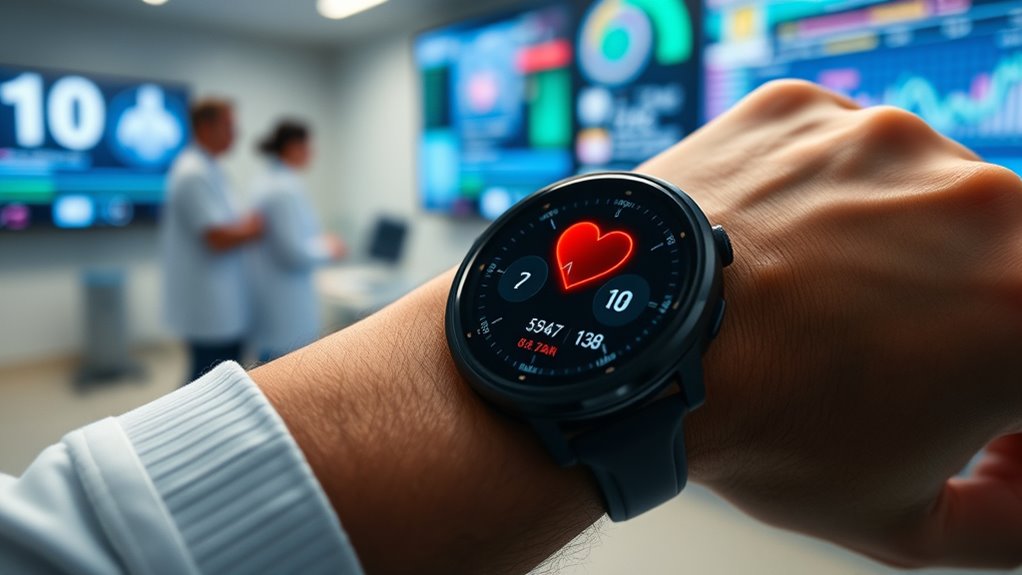
Integrating wearable devices with healthcare systems is essential for delivering all-encompassing and timely patient data. By enabling interoperability, health metrics from wearables can seamlessly update electronic health records, providing clinicians with comprehensive insights.
Standardized data formats like HL7 FHIR support smooth data sharing across platforms, ensuring accurate and consistent information transfer. Secure exchange frameworks protect patient privacy and comply with regulations such as HIPAA, allowing safe remote monitoring and real-time data transmission.
APIs facilitate direct access to wearable data within existing clinical workflows, helping healthcare providers make more informed decisions. This integration fosters continuous, personalized care by making health metrics readily available, improving patient engagement and enabling proactive interventions.
Ultimately, it bridges the gap between wearable technology and traditional healthcare systems.
Impact of Wearable Technology on Patient Outcomes
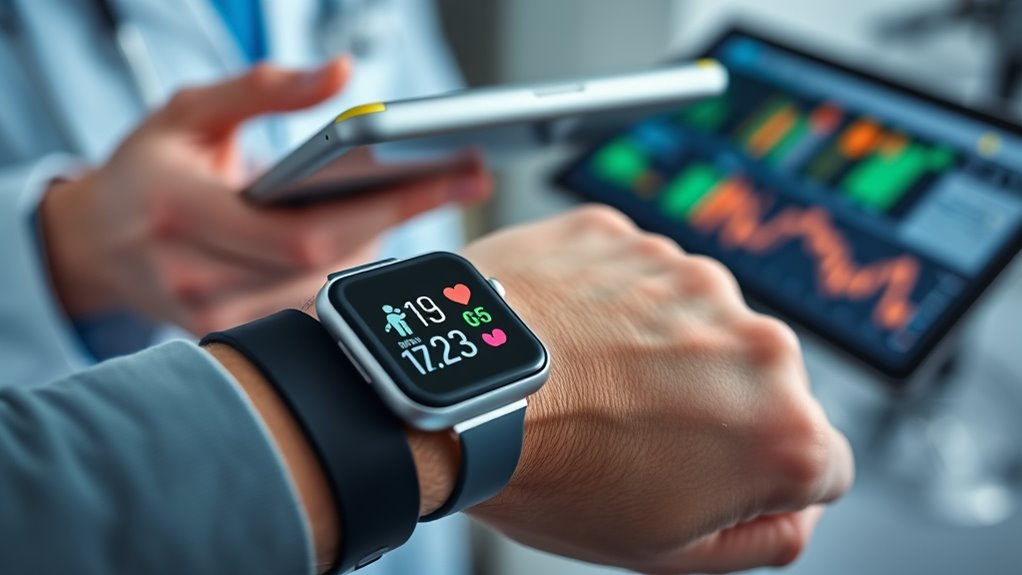
Connecting wearable technology with healthcare systems allows for continuous data collection that can directly influence patient outcomes. Wearable devices enable real-time health monitoring, leading to earlier detection of issues and better chronic disease management. Studies show patients using wearables experience fewer hospital readmissions and are more adherent to treatments. Integrating wearable data into clinical workflows boosts diagnostic accuracy and supports personalized care. Wearables also promote proactive healthcare by providing alerts and trend analysis, preventing complications and aiding recovery. As a result, patient engagement increases, empowering individuals to take control of their health. The table below highlights key benefits:
| Benefit | Example | Impact |
|---|---|---|
| Improved health monitoring | Continuous vital sign tracking | Better health outcomes |
| Enhanced patient engagement | Real-time data sharing | Increased adherence |
| Chronic disease management | Remote glucose or blood pressure monitoring | Reduced hospital visits |
Challenges and Considerations in Using Health Wearables
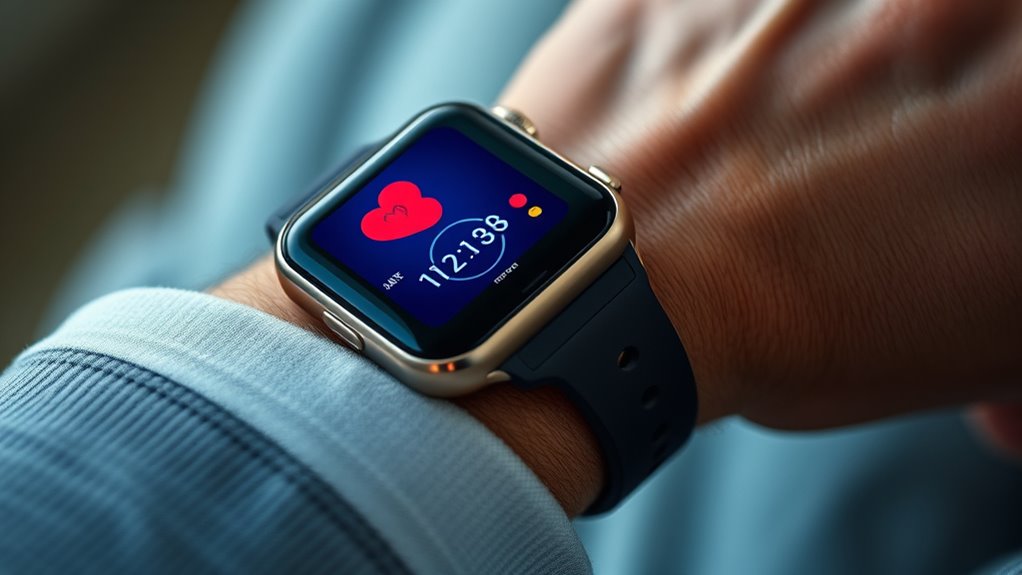
Managing the vast amounts of continuous data generated by wearables presents significant challenges for healthcare providers. You need automation and advanced analytics to sift through the data and identify meaningful trends, but ensuring data privacy and security remains essential.
Wearables collect sensitive health information that must comply with regulations like HIPAA and GDPR, making data security a top priority.
Device accuracy and reliability can vary, impacting clinical decision-making, especially when consumer devices are used for medical purposes.
Interoperability also poses a challenge; integrating diverse devices with existing healthcare systems requires robust standards and staff training.
Additionally, hardware durability and battery life limitations can hinder long-term use, particularly among older or less tech-savvy users, complicating consistent health monitoring.
Future Directions and Innovations in Wearable Health Monitoring
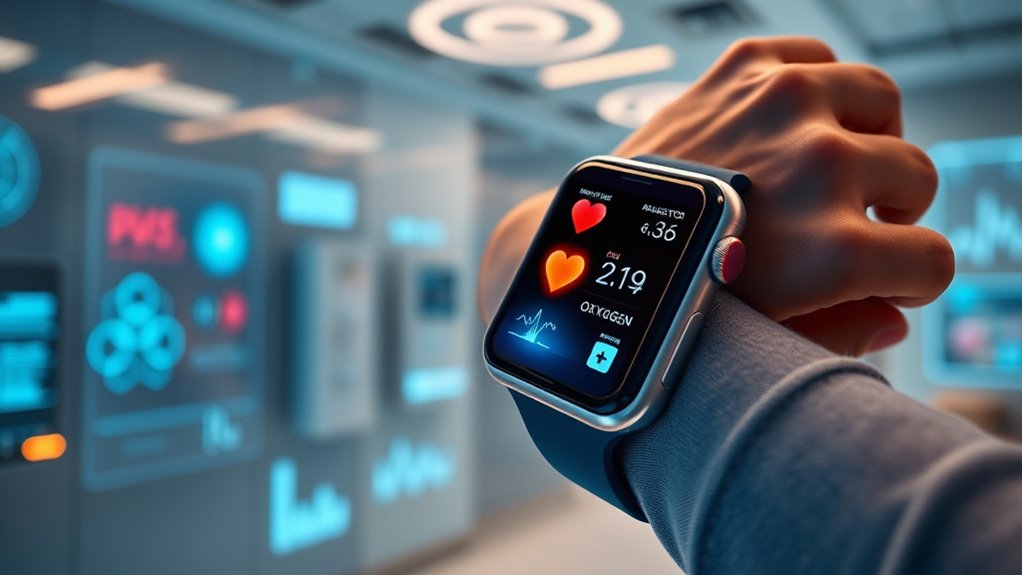
Advances in artificial intelligence and machine learning are transforming wearable health monitoring by providing more personalized insights and accurate predictive analytics.
Sensor technology, such as non-invasive sensors embedded in epidermal patches and fabrics, enables continuous, real-time monitoring of vital signs and biomarkers with greater comfort and precision.
AI-driven analytics refine data interpretation, reducing false positives and supporting clinical decision-making.
Future innovations will focus on enhancing interoperability standards to seamlessly integrate wearable data with electronic health records, streamlining healthcare workflows.
These developments will also incorporate context-aware data quality standards, minimizing false alarms and ensuring reliable, meaningful health information.
As technology evolves, wearables will become smarter, more integrated, and essential tools for proactive health management and improved patient outcomes.
Frequently Asked Questions
What Is the Best Wearable Device to Monitor Health?
You’re asking about the best wearable device to monitor health, and it really depends on your needs.
If you want extensive features like ECG and fall detection, the Apple Watch Series 8 or Ultra is excellent.
For overall wellness, the Fitbit Sense 2 offers advanced metrics.
If you need medical-grade accuracy, the Withings ScanWatch or KardiaMobile is ideal.
For fertility tracking, the Ava Women bracelet provides detailed reproductive insights.
What Is a Wearable Health Monitoring Device?
A wearable health monitoring device is a gadget you wear on your body that tracks essential signs like heart rate, blood pressure, glucose, and sleep patterns.
You can find smartwatches, fitness trackers, and biosensors that collect data continuously and send it to your phone or healthcare provider.
These devices are easy to use, non-invasive, and help you stay proactive about your health by providing real-time insights and early warnings.
What Are the 4 Wearable Technologies?
Think of these four wearable techs as your health’s own Avengers. First, smartwatches keep tabs on your heart and sleep, much like Iron Man’s sensors.
Fitness trackers motivate you to move, echoing Captain America’s strength.
Biosensors detect biomarkers, like Doctor Strange’s mystical tools.
ECG monitors analyze your heart’s rhythm, similar to Batman’s detective skills.
Together, they empower you to take control of your health every day.
What Are Examples of Wearable Health Devices?
You’re curious about examples of wearable health devices, and there are many to reflect on. Fitness trackers like Fitbit monitor your activity and sleep.
While smartwatches such as the Apple Watch track heart rate, ECG, and fall detection. Biosensors like Abbott’s glucose monitors track blood sugar levels continuously.
For infants, devices like Owlet monitor heart rate and oxygen, and specialized wearables like Ava help track fertility, stress, and sleep.
Conclusion
As wearable technology continues to evolve, the potential for transforming healthcare is immense. You might soon discover innovations that seamlessly blend into your daily life, providing real-time insights and personalized care like never before. But as these devices become more integrated and powerful, questions about privacy, accuracy, and accessibility loom on the horizon. Are you ready to embrace the future of health monitoring, where your wellbeing is just a wearable away? The next breakthrough could be closer than you think.









